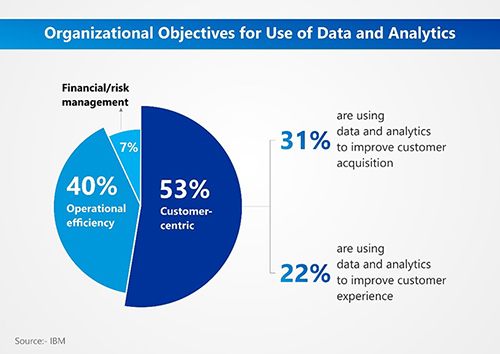
- 81% of employees think data must be at the core of every decision-making.
- A large number of CEOs back this view.
- 50% of CEOs want analytics to be right under them, reporting closely.
- 2 out of 3 CEOs captured more data in 2018 than they did in 2019.
But,
- 45% of CEOs say inadequate data insights are hindering their customer insights.
- 89% of CEOs believe they will lose their market share in the absence of big data insights.
- 56% of CEOs do not trust the validity of their data.
Lisa Heneghan, the Global Head of Technology, Management Consulting, KPMG International, outlines this apprehension “If you're relying on software to make the decisions for you, at what point can you trust that those decisions are going to be the right ones?”
This is where Data Science professionals come into the picture. Data Science professionals are the crucial link between the prized data insights that are out there waiting to be discovered and the CEOs who desperately need them. This brings both responsibility and opportunity to make a change and drive impact across sectors.
Few Data Science professionals are dearer to the c-suite than the others:Much data comes as muck, and if not addressed in the right manner, the insights from them can be muck, too. Internal customers, stakeholders, are exactly like your external customers; if you don’t give them the kind of product or service they want, in the way that they want, they won’t buy it.
The strategies outlined in this article can help Data Science professionals understand the kind of information CEOs are looking for and build trust among them by delivering the right information at the right time. This will justify the ROI on the hefty investment that leaders made in analytics and will carve an irreplaceable niche for data science professionals.
Priorities for CEOs are changing and so must the insights delivered to them:In 2019, CEOs pinned their attention on three focus areas: competition, customer experience that drives addition of new customers and operational efficiency. Here’s how expert Data Science Professionals assisted them:
Cross-sector insights:Organizations transitioned from products and services to ecosystems and platforms enabling ecosystem strategy. Seven out of 10 world’s biggest organizations used disruptive technologies to not only disrupt their own sector or market but to remodel broader stretch of related businesses. The trend was also visible in fast-growing S&P 500s that invested substantially in building ecosystems. This changed the competition dynamics. Today, CEOs of large established companies can any time be challenged by industries and companies they never thought of as competitors before. Data Science Professionals addressed this need by facilitating cross-sector insights and giving a broader picture of the situation. By doing so they cleared the fog and added tremendous value to business decisions.
They asked questions like:
- Who was the next competitor?
- How distinct the new customers were?
- What was the most effective path forward?
- Who the customers were?
- Who was the next prospect for a merger or acquisition?
- How new business models could address the existing customer need in a better way?
- How the new model could help the existing model?
In the last few years, data emerged as both an opportunity and a challenge. The explosion of the personal data dawned as a boon for businesses who understood it and managed to streamline it. But this was a tiny piece of the pie. Most CEOs were perplexed with the volume and noise of it.
Those who understood data focused on two major objectives: customer acquisition and customer experience. IBM has outlined the extent to which these priorities were taken ahead.

Here’s how Data Science Professionals focused their efforts on these pain points. They identified:
- Who were the customers the business was likely to lose?
- How the organization could improve the customer experience for these unhappy customers?
- How customer-needs were changing?
- How their business could address these changing needs?
By doing so, for product-based companies, they helped create, analyze and improve the value-added services.
Operational efficiency:As the profit margins shrink, re-arranging the operations in minimum possible costs, becomes a must for the organizations. Data Science insights emerged as a top-up for the lean system.
With data insights, organizations identified:
- Which were the most crucial vacancies for them?
- How customers behaved in the past and how they are likely to behave in the future?
- Which supply chain would be most efficient?
They identified the sources of value or which part of the value chain had the most potential then figured the possible use cases and arrived at priority.
Let’s talk about numbers:Neil Patel said, “A successful company is never content to rest on its laurels – it’s always learning, adapting and growing – fueled by data and science.”
Here’s a list of few companies that have taken the technology-driven and data-centric approach to drive customer centric business transformation and exceptional customer engagement.
- Netflix personalized its suggestions and trimmed customer churn by USD 1 billion.
- Delta checked its customer sentiments on Twitter and improved its customer experience.
- UPS optimized its fleet and saved USD 300 million per annum.
- Airbnb boosted its customer bookings in 4 countries by 10%.
- Nucleus Research found an ROI of 212%.”
The list of successes is unending.
Business in the age of dataWe are slowly moving towards the post digital era where data becomes like air. Everyone has it and everyone needs more of it. While most big organizations and many mid-size organizations have invested hefty sums in incorporating data into their systems, few know how to capture the ROI from the investments they have made. There’s no stopping you if you master this skill. You could be the CEO’s go-to person for insights right away.
To do so:
Analyze the business outcomes and correlate them with analytics. Check how analytics might affect those outcomes. Begin by identifying data and insights that can add maximum value to the existing business model. Once you assure your goals, fix your data before working on it.
- Keep your gut feeling aside.
- Don’t focus on isolated data sets.
- Consider all data sources while collecting data.
- Pin your audience, your product or service and ensure the relevancy of your data for that specific set.
Present a solution that can be measured in crisp numbers. Identify, outline, prioritize and phase use cases. If you are having issues identifying opportunities, outlining problems or figuring a solution, get a translator who can present the business applicability of your insights.
For more insights or help, contact DASCA.
































